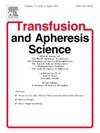Factors affecting the development of hypokalemia during apheresis in healthy donors
IF 1.2
4区 医学
Q4 HEMATOLOGY
引用次数: 0
Abstract
Despite being generally safe, apheresis for peripheral blood stem cell collection potentially disrupts electrolyte balance owing to the use of citric acid as an anticoagulant. As prior research has primarily studied hypocalcemia, information on the kinetics of potassium levels during apheresis in healthy donors is scarce. We investigated the fluctuation in potassium levels during apheresis and the risk factors for hypokalemia. This subanalysis used data from an open-label, randomized controlled trial of “oral calcium supplementation versus placebo in mitigating citrate toxicity” conducted between January 2021 and July 2022, at Okayama University Hospital. Potassium levels were significantly reduced after 5-day granulocyte colony-stimulating factor (G-CSF) administration (p < 0.0001), with seven patients (16.7 %) given oral potassium administration before apheresis because the treating physician deemed potassium levels potentially unsafe and three (7.1 %) presenting with hypokalemia at apheresis. Potassium levels after apheresis were significantly lower than those before apheresis (baseline; p < 0.0001), and 28 of 42 donors (66.7 %) experienced biochemical, clinically unapparent hypokalemia immediately after the completion of apheresis. A > 15 % reduction in potassium levels from baseline was associated with age and the acid citrate dextrose solution A (ACD-A) volume in univariate analysis. In the multivariable analysis, both factors were associated (hazard ratio [HR], 11.60; 95 % confidence interval [CI], 1.60–83.70; p = 0.02 and HR, 17.50; 95 % CI, 1.07–136.00; p = 0.04). In conclusion, G-CSF administration and apheresis ultimately induced hypokalemia in two-thirds of the donors. Older age and higher ACD-A volume may affect potassium levels during apheresis in healthy donors.
Clinical Trial registration: jRCTs061200035.
影响健康献血者采血时低血钾发生的因素
尽管通常是安全的,但由于使用柠檬酸作为抗凝剂,外周血干细胞收集的单采术可能会破坏电解质平衡。由于先前的研究主要是研究低钙血症,关于健康献血者采血过程中钾水平的动力学信息很少。我们调查了采血过程中钾水平的波动和低钾血症的危险因素。该亚分析使用了2021年1月至2022年7月在冈山大学医院进行的一项开放标签随机对照试验的数据,该试验是“口服补钙与安慰剂减轻柠檬酸盐毒性”。给予粒细胞集落刺激因子(G-CSF) 5天后,钾水平显著降低(p <; 0.0001),其中7名患者(16.7 %)在采血前口服钾,因为治疗医生认为钾水平可能不安全,3名患者(7.1 %)在采血时出现低钾血症。采血后的钾水平明显低于采血前(基线;P <; 0.0001),42名献血者中有28名(66.7 %)在完成采血后立即出现生化、临床不明显的低钾血症。在单变量分析中,钾水平较基线降低了1 >; 15 %,与年龄和柠檬酸葡萄糖溶液A (ACD-A)体积有关。在多变量分析中,这两个因素是相关的(风险比[HR], 11.60;95 %置信区间[CI], 1.60-83.70;p = 0.02,HR为17.50;95 % ci, 1.07-136.00; = 0.04页)。总之,G-CSF给药和单采最终导致三分之二的供体低钾血症。年龄较大和较高的ACD-A容量可能影响健康献血者采血时的钾水平。临床试验注册号:jRCTs061200035。
本文章由计算机程序翻译,如有差异,请以英文原文为准。
求助全文
约1分钟内获得全文
求助全文
来源期刊
CiteScore
3.60
自引率
5.30%
发文量
181
审稿时长
42 days
期刊介绍:
Transfusion and Apheresis Science brings comprehensive and up-to-date information to physicians and health care professionals involved in the rapidly changing fields of transfusion medicine, hemostasis and apheresis. The journal presents original articles relating to scientific and clinical studies in the areas of immunohematology, transfusion practice, bleeding and thrombotic disorders and both therapeutic and donor apheresis including hematopoietic stem cells. Topics covered include the collection and processing of blood, compatibility testing and guidelines for the use of blood products, as well as screening for and transmission of blood-borne diseases. All areas of apheresis - therapeutic and collection - are also addressed. We would like to specifically encourage allied health professionals in this area to submit manuscripts that relate to improved patient and donor care, technical aspects and educational issues.
Transfusion and Apheresis Science features a "Theme" section which includes, in each issue, a group of papers designed to review a specific topic of current importance in transfusion and hemostasis for the discussion of topical issues specific to apheresis and focuses on the operators'' viewpoint. Another section is "What''s Happening" which provides informal reporting of activities in the field. In addition, brief case reports and Letters to the Editor, as well as reviews of meetings and events of general interest, and a listing of recent patents make the journal a complete source of information for practitioners of transfusion, hemostasis and apheresis science. Immediate dissemination of important information is ensured by the commitment of Transfusion and Apheresis Science to rapid publication of both symposia and submitted papers.

 求助内容:
求助内容: 应助结果提醒方式:
应助结果提醒方式:


